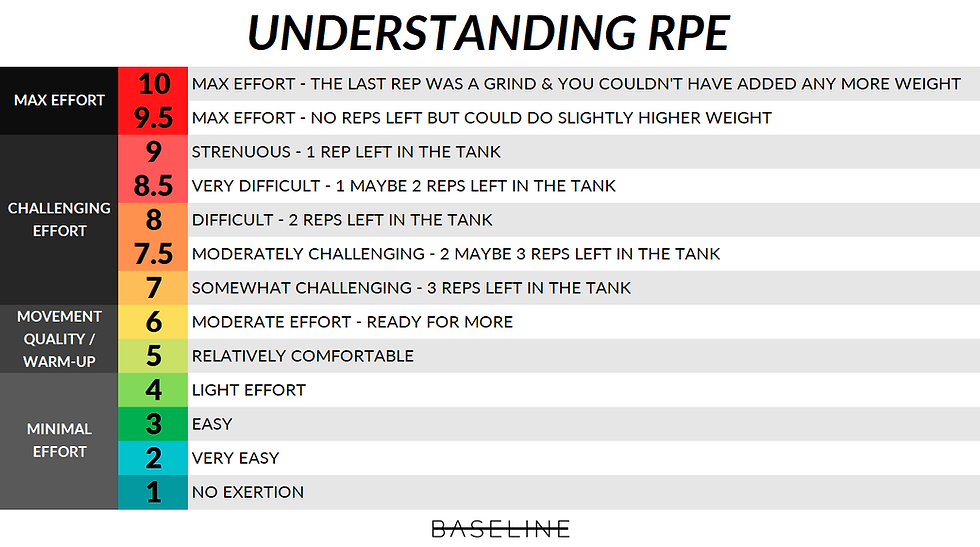How to Choose Weights: Rep Ranges & RPE Explained
- Brandon Yach
- Nov 1, 2023
- 3 min read
Updated: Nov 2, 2023
At Baseline, we focus on intuitive and adaptive strength training, allowing individuals to respond to how they're feeling on any given day as well as their body's cues in real-time. As such, we don't typically prescribe specific weights or percentages for strength and build work. Instead, we guide athletes to understand their capacities and adapt their weights based on a combination of prescribed rep ranges and the rate of perceived exertion (RPE). It may take a little time and practice to fully tune into your body, but it's a strategy that pays off.
Understanding RPE
RPE, or "rate of perceived exertion," is an invaluable tool to gauge how hard you feel you're working during a session. Essentially, it measures your "effort."
When utilizing the 1-10 RPE scale, there's an inherent link between your chosen level and the reps in reserve (RIR). The RIR indicates how many more reps you could execute with good form before fatigue sets in and you can't perform any additional repetitions.
For instance, when an exercise prescribes an RPE of 8/10, it implies selecting a weight that represents a 8 out of 10 effort level for the given reps. In this scenario, upon completing the recommended reps, you'd still have the capacity to perform about 2 more with proper form (indicating 2 RIR). Ideally, most non "warm-up" sets should have an RPE between 7/10 and 9/10.

Choosing Weights Based on Rep Ranges
If a repetition range is given, such as 8-10 reps per set, aim for the top end of this range. If you can complete the maximum number of reps within a given range while:
Maintaining great form
Adhering to the provided tempo
Applying an RPE/effort less than 8 or 9 out of 10
Then consider increasing the weight in subsequent sets or in future sessions. It's a great idea to track the weights you're using over time - the Baseline Elevate App provides an extremely easy way to do this and look back at previously used weights.
It's easy to get caught up in always trying to beat your previous numbers, but focusing on the movement's quality is paramount. Using minimal weight or even bodyweight can provide significant benefits if done properly and tempo is adhered to. It's always better to prioritize the quality of movement and prescribed tempo rather than overload yourself with weight and perform movements with poor form and/or tempo.
However, as a general principle, as the prescribed repetitions decrease during sessions or from week to week, you should aim to increase your weights accordingly. This offers a chance to enhance both load and movement quality over time, especially as similar movements and exercises appear from week to week. The idea is to provide your body the right amount of challenging stimulus so that next time your body faces the same demand, it's better equipped and easier to overcome it. This is otherwise known as Progressive Overload - the fundamental process of safely guiding your body to adapt to different stressors that are placed on it over a period of time so that strength & cardiovascular adaptations can occur.
Practical Tips
Perform an extra warm-up set using a weight that's definitely too light. This will allow you to get a feel for both the movement and how your body feels. Depending on how heavy your "working weight" is (the weight you would use for your actual sets), progressively increase your weight in a gradual manner while performing 1-2 more warm-up sets until you feel confident and ready to lift your working weight.
When in doubt, be more conservative and use lighter weight until you are confident your movement quality can be sustained throughout every set.
Reference what weight you may have used in the past for a particular movement and rep range to help guide you select a weight for your first set.
Final Thoughts
Mastering the balance between rep ranges and RPE can be a game-changer in your strength training journey. It empowers you to understand your body better and make choices that promote consistent progress, optimal results, and minimized injury risk. Remember to always prioritize movement quality and listen to your body's feedback. Happy lifting!
.png)

